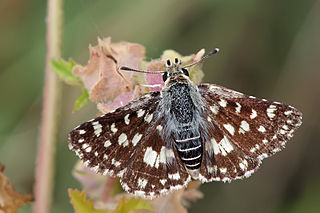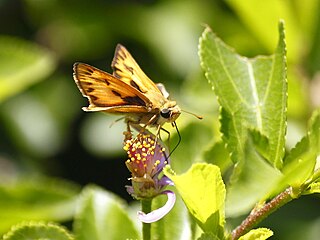
Skippers are a group of butterflies placed in the family Hesperiidae within the order Lepidoptera. They were previously placed in a separate superfamily, Hesperioidea; however, the most recent taxonomy places the family in the superfamily Papilionoidea, the butterflies. They are named for their quick, darting flight habits. Most have their antenna tips modified into narrow, hook-like projections. Moreover, skippers mostly have an absence of wing-coupling structure available in most moths. More than 3500 species of skippers are recognized, and they occur worldwide, but with the greatest diversity in the Neotropical regions of Central and South America.

The superfamily Papilionoidea contains all the butterflies except for the moth-like Hedyloidea.

The small skipper is a butterfly of the family Hesperiidae.

The large skipper is a butterfly of the family Hesperiidae.

Pyrgus malvae, the grizzled skipper, is a butterfly species from the family Hesperiidae. It is a small skipper (butterfly) with a chequered pattern on its wings that appears to be black and white. This butterfly can be found throughout Europe and is common in central and southern regions of England. The butterfly prefers three major types of habitat: woodland, grassland, and industrial. Referenced as a superspecies, Pyrgus malvae includes three semispecies: malvae, malvoides, and melotis. Eggs are laid on plants that will provide warmth and proper nutrition for development. As larvae, their movement is usually restricted to a single plant, on which they will build tents, unless they move onto a second host plant. Larvae then spin cocoons, usually on the last host plant they have occupied, where they remain until spring. Upon emerging as adult butterflies, grizzled skippers are quite active during the day and tend to favour blue or violet-coloured plants for food. They also possess multiple methods of communication; for example, vibrations are used to communicate with ants, and chemical secretions play a role in mating. Exhibiting territorial behaviour, males apply perching and patrolling strategies to mate with a desired female.

Grass skippers or banded skippers are butterflies of the subfamily Hesperiinae, part of the skipper family, Hesperiidae. The subfamily was established by Pierre André Latreille in 1809.

Pyrginae, commonly known as spread-winged skippers, are a subfamily of the skipper butterfly family (Hesperiidae). The subfamily was established by Hermann Burmeister in 1878. Their delimitation and internal systematics has changed considerably in recent years with the most recent review being in 2019.

Pyrgus is a genus in the skippers butterfly family, Hesperiidae, known as the grizzled skippers. The name "checkered" or "chequered skipper" may also be applied to some species, but also refers to species in the genera Burnsius and Carterocephalus. They occur in the Holarctic with an additional group of species extending to the Neotropic.

Erionota thrax, the palm redeye or the banana skipper, is a species of butterfly belonging to the family Hesperiidae. It is found from India, through south-eastern Asia to Papua New Guinea. In the north it is found up to southern China. It is an introduced species on various Pacific islands, including the Solomon Islands and Hawaii. It has also been recorded from Mauritius.

Gegenes nostrodamus, commonly known as the dingy swift, light pygmy skipper, Mediterranean skipper or veloz de las rieras, is a butterfly belonging to the family Hesperiidae. It is found from the Mediterranean Sea, through Anatolia to Turkestan and India.

Coeliadinae is a subfamily of the skipper butterfly family (Hesperiidae). With about 150 described species, this is one of several smallish skipper butterfly subfamilies. It was first proposed by William Frederick Evans in 1937.

Firetips or firetail skippers are skipper butterflies in the subfamily Pyrrhopyginae. The roughly 150 species are found only in the Neotropics, with the exception of one species which just reaches into the United States. Their common names refer to the red tuft at the end of the abdomen of many Pyrrhopyginae.

The fiery skipper is a species of butterfly in the family Hesperiidae. Reaching approximately 1 inch (2.5 cm) in length, male fiery skippers are orange or yellow while the females are dark brown. Small brown spots may be observed on both the hindwing and forewing of both sexes although to a varying degree. Females may be darker brown overall with pale checkered markings on the hindwing. Fiery skipper larvae, or caterpillars, are greenish pink-grey with a black head and constricted neck. These larvae are often considered pests and can feed on Bermudagrass, creeping bentgrass, and St. Augustine grass.

Euschemon is a genus of skipper butterflies in the family Hesperiidae. It is monotypic, being represented by the single species Euschemon rafflesia, commonly known as the regent skipper and is found in Australia.

The giant skippers (Megathymini) are a tribe of butterflies in the family Hesperiidae.

Arteurotia is a genus of skipper butterflies genus in the family Hesperiidae.

Gegenes hottentota, the marsh Hottentot skipper, Hottentot skipper or Latreille's skipper, is a butterfly of the family Hesperiidae. It is found in Africa and south-western Arabia. The habitat consists of marshy areas with thick grass, especially in valleys.

The Erionotini are a tribe of skipper butterflies in the subfamily Hesperiinae.

Semalea pulvina, the silky dart, silky skipper or branded silky skipper, is a butterfly in the family Hesperiidae. It is found in Senegal, Guinea-Bissau, Guinea, Sierra Leone, Liberia, Ivory Coast, Ghana, Togo, Nigeria, Cameroon, Gabon, the Republic of the Congo, the Democratic Republic of the Congo, Uganda, western Kenya, Tanzania, Malawi, northern Zambia, Mozambique and eastern Zimbabwe. The habitat consists of forests.

















